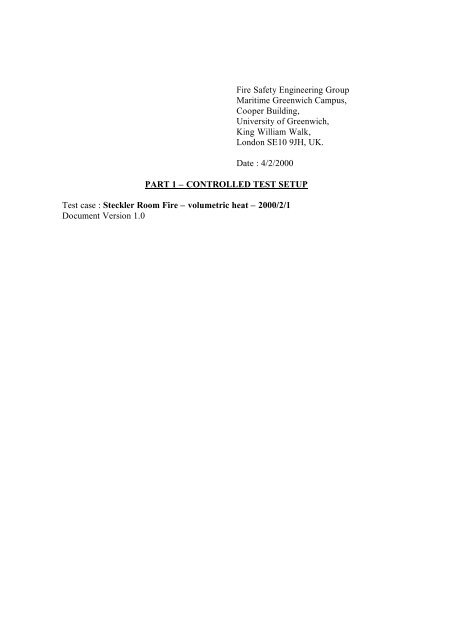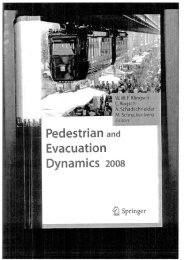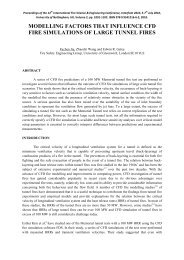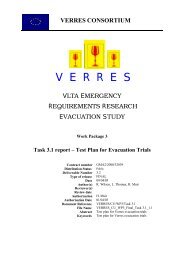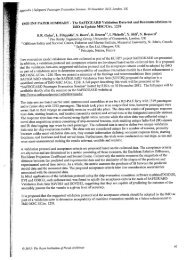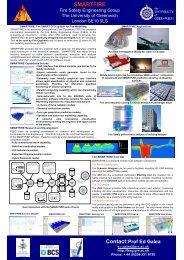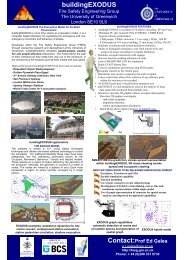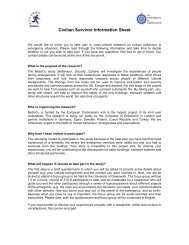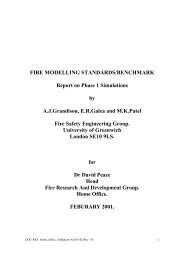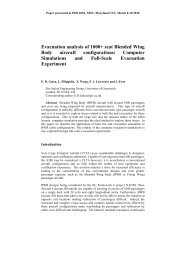2000/2/1 Steckler Room - Fire Safety Engineering Group - University ...
2000/2/1 Steckler Room - Fire Safety Engineering Group - University ...
2000/2/1 Steckler Room - Fire Safety Engineering Group - University ...
Create successful ePaper yourself
Turn your PDF publications into a flip-book with our unique Google optimized e-Paper software.
<strong>Fire</strong> <strong>Safety</strong> <strong>Engineering</strong> <strong>Group</strong><br />
Maritime Greenwich Campus,<br />
Cooper Building,<br />
<strong>University</strong> of Greenwich,<br />
King William Walk,<br />
London SE10 9JH, UK.<br />
Date : 4/2/<strong>2000</strong><br />
PART 1 – CONTROLLED TEST SETUP<br />
Test case : <strong>Steckler</strong> <strong>Room</strong> <strong>Fire</strong> – volumetric heat – <strong>2000</strong>/2/1<br />
Document Version 1.0
PART 1 – CONTROLLED TEST SETUP<br />
Case: <strong>Steckler</strong> <strong>Room</strong> <strong>Fire</strong> – volumetric heat – <strong>2000</strong>/2/1<br />
User details<br />
Run by:<br />
Address:<br />
Date:<br />
Phone no:<br />
email:<br />
<strong>Fire</strong> modelling Software<br />
SMARTFIRE CFX PHOENICS<br />
Version/build number___________<br />
Date of release_________________<br />
Operating System<br />
Windows 95/98/<strong>2000</strong> Windows NT Unix Dos<br />
Version/build number_____________________<br />
Machine<br />
PC<br />
Unix Workstation<br />
CPU:<br />
Memory:<br />
Case description<br />
The experimental data obtained from <strong>Steckler</strong>’s fire tests* which have been used as part<br />
of the validation process for both zone and field fire models. The data represents nonspreading<br />
fires in small compartments. The non-spreading fire was created using a<br />
centrally located (position A in Figure 1) 62.9kW methane burner with a diameter of<br />
0.3m and a height of 0.3m. The experiments were conducted by <strong>Steckler</strong> et al. in a<br />
compartment measuring 2.8m × 2.8m in plane and 2.18m in height (see Figure 1) with a<br />
doorway centrally located in one of the walls measuring 0.74m wide by 1.83m high. The<br />
walls and ceiling were 0.1m thick and they were covered with a ceramic fibre insulation<br />
board to establish near steady state conditions within 30 minutes.
Figure 1 – Configuration of <strong>Steckler</strong> room<br />
The door measures 0.74m wide and 1.83m high and is centrally located in one of the<br />
walls.<br />
*<strong>Steckler</strong>, K.D, Quintiere, J.G and Rinkinen, W.J.[1982], "Flow induced by fire in a<br />
compartment", NBSIR 82-2520, National Bureau of Standards.<br />
Required Results<br />
The results should be supplied as graphs and as Excel97 worksheets<br />
Vertical Corner Stack temperatures at 0.305 from the front and side walls.<br />
Vertical Doorway temperature profile in the middle of the doorway.<br />
Horizontal velocity profile for a vertical stack in the middle of the doorway.<br />
These should all be plotted with height of the variable on the y-axis and the variable<br />
value (temperature or horizontal velocity) on the x-axis.<br />
CFD set up<br />
1D 2D 3D
Transient<br />
Steady State<br />
The case needs to be run for 200s using 1s timesteps. This effectively gives a steady state<br />
result.<br />
Differencing Schemes<br />
Temporal:<br />
Fully Implicit Crank-Nicolson Explicit Exponential<br />
Spatial:<br />
Hybrid Central Difference Upwind<br />
Notes:<br />
Physical Models<br />
Radiation Model (if not listed please specify in the space provided)<br />
None Six flux Discrete Transfer Monte Carlo Radiosity<br />
Notes:<br />
(1) If the fire modelling software does not possess the six-flux model, a discrete transfer<br />
model may be used in place of the six-flux model. If the discrete transfer model must<br />
be used instead of a six flux model then the discrete model must be made to emulate<br />
the behaviour of the six-flux model. This can be achieved by using 6 rays in the coordinate<br />
directions. If a radiation mesh needs to be specified, this should be identical<br />
to the flow mesh. If this is not possible, then at least the same number of cells in each<br />
direction must be specified. The details of the mesh must also be provided with your<br />
results.<br />
Parameters<br />
The absorption coefficient (a) assumed the following form:<br />
a = 0.315<br />
It is assumed there is no scattering so s = 0.0.<br />
Turbulence model (if not listed please specify in the space provided)<br />
Laminar k- ε buoyancy modified k-ε RNG
Notes:<br />
Turbulence Parameters * :<br />
C µ σ k σ ε C 1ε C 2ε C 3<br />
0.09 1.0 1.3 1.44 1.92 1.0<br />
* If different parameters are being used please specify in the table above.<br />
Combustion Model (if not listed please specify in the space provided)<br />
none Volumetric heat source Mixed is burnt Eddy break up<br />
Magnussen soot model<br />
Combustion Parameters:<br />
The volumetric heat source is assumed to be centrally located within the room with<br />
dimension of 0.3m x 0.3m x 0.3m with a total heat source of 62.9kW.<br />
Compressibility<br />
Incompressible Boussinesq Weakly compressible Fully compressible<br />
Compressibility Parameters:<br />
External Pressure 1.01325e+05 Pa<br />
Buoyancy<br />
Yes No<br />
Gravity<br />
-9.81m/s in the v-velocity direction.<br />
Material Properties<br />
Material Name<br />
Density<br />
Viscosity (dynamic)<br />
Conductivity<br />
Specific heat capacity<br />
Air<br />
Determined by compressibility (Ideal Gas Law) Molecular<br />
Weight of air is 29.35<br />
Laminar 1.798e-005 kg/m.s<br />
0.02622 W/m.K<br />
1007.0 J/kg.K<br />
Initial Values<br />
U-VELOCITY 0.0<br />
V-VELOCITY 0.0<br />
W-VELOCITY 0.0<br />
PRESSURE 0.0
TEMPERATURE 293.75<br />
KINETIC ENERGY 0.01<br />
DISSIPATION RATE 0.01<br />
Boundary conditions<br />
All walls are assumed to be adiabatic for the first phase of the validation process. In the<br />
first phase of validation the walls are perfect reflectors of radiation, i.e. the emissivity of<br />
the walls is 0.<br />
The doorway measures 0.74m wide and 1.83m high and is centrally located in one of the<br />
walls. This doorway is modelled using three solid non conducting obstructions to create<br />
the walls around the doorway. An extended region for this doorway is required to ensure<br />
that the airflow in the door is correctly modelled.<br />
On the extended region all the boundary patches are fixed pressure (outlet) boundaries set<br />
to 0.0 Pa apart from the floor which is adiabatic.<br />
The fire is modelled as a volumetric heat source which is assumed to be centrally located<br />
within the room on the floor with dimensions of 0.3m x 0.3m x 0.3m with a total heat<br />
source of 62.9kW.<br />
Mesh<br />
31 20 21
X<br />
0.0 0.056 0.1157 0.2137 0.3407 0.4872 0.6438 0.8011 0.9498<br />
1.0805 1.1837 1.25 1.325 1.4 1.475 1.55 1.6163 1.7303<br />
1.8787 2.0481 2.2252 2.3966 2.5491 2.6694 2.744 2.8 2.9<br />
3.0115 3.2949 3.7272 4.2979 5.0<br />
Y<br />
0.0 0.044 0.1293 0.2147 0.3 0.3638 0.4612 0.5858 0.7308<br />
0.8896 1.0555 1.222 1.3824 1.53 1.6582 1.7605 1.83 1.9387<br />
2.0473 2.156 2.2<br />
Z<br />
0.0 0.056 0.142 0.3151 0.5328 0.7527 0.9326 1.03 1.14 1.25<br />
1.35 1.45 1.55 1.66 1.77 1.856 2.0291 2.2468 2.4667 2.6466<br />
2.744 2.8<br />
Model Definition files<br />
Convergence<br />
Please specify your convergence criteria including type of error estimator and tolerance<br />
value for each variable<br />
Runtime<br />
Results files/Archiving:<br />
Document cross-reference:<br />
User Guides, etc<br />
Comments


